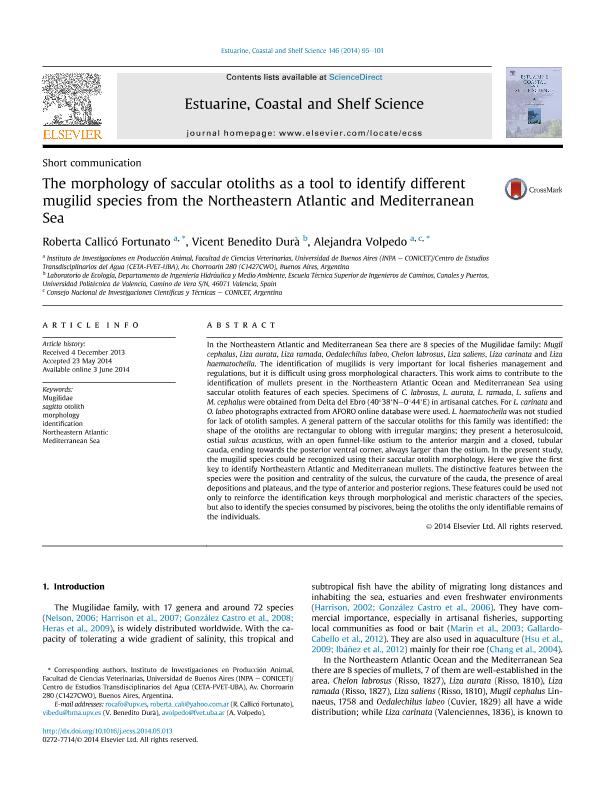Mostrar el registro sencillo del ítem
dc.contributor.author
Callicó Fortunato, Roberta Glenda

dc.contributor.author
Benedito Durà, Vicent
dc.contributor.author
Volpedo, Alejandra

dc.date.available
2016-11-09T19:17:19Z
dc.date.issued
2014-06
dc.identifier.citation
Callicó Fortunato, Roberta Glenda; Benedito Durà, Vicent; Volpedo, Alejandra; The morphology of saccular otoliths as a tool to identify different mugilid species from the Northeastern Atlantic and Mediterranean Sea; Elsevier; Estuarine, Coastal And Shelf Science; 146; 6-2014; 95-101
dc.identifier.issn
0272-7714
dc.identifier.uri
http://hdl.handle.net/11336/8097
dc.description.abstract
In the Northeastern Atlantic and Mediterranean Sea there are 8 species of the Mugilidae family: Mugil cephalus, Liza aurata, Liza ramada, Oedalechilus labeo, Chelon labrosus, Liza saliens, Liza carinata and Liza haematocheila. The identification of mugilids is very important for local fisheries management and regulations, but it is difficult using gross morphological characters. This work aims to contribute to the identification of mullets present in the Northeastern Atlantic Ocean and Mediterranean Sea using saccular otolith features of each species. Specimens of C. labrosus, L. aurata, L. ramada, L. saliens and M. cephalus were obtained from Delta del Ebro (40°38’N–0°44’E) in artisanal catches. For L. carinata and O. labeo photographs extracted from AFORO online database were used. L. haematocheila was not studied for lack of otolith samples. A general pattern of the saccular otoliths for this family was identified: the shape of the otoliths are rectangular to oblong with irregular margins; they present a heterosulcoid, ostial sulcus acusticus, with an open funnel-like ostium to the anterior margin and a closed, tubular cauda, ending towards the posterior ventral corner, always larger than the ostium. In the present study, the mugilid species could be recognized using their saccular otolith morphology. Here we give the first key to identify Northeastern Atlantic and Mediterranean mullets. The distinctive features between the species were the position and centrality of the sulcus, the curvature of the cauda, the presence of areal depositions and plateaus, and the type of anterior and posterior regions. These features could be used not only to reinforce the identification keys through morphological and meristic characters of the species, but also to identify the species consumed by piscivores, being the otoliths the only identifiable remains of the individuals.
dc.format
application/pdf
dc.language.iso
eng
dc.publisher
Elsevier

dc.rights
info:eu-repo/semantics/openAccess
dc.rights.uri
https://creativecommons.org/licenses/by-nc-nd/2.5/ar/
dc.subject
Mugilidae
dc.subject
Sagitta Otolith Morphology I
dc.subject
Northeastern Atlantic
dc.subject
Mediterranean Sea
dc.subject.classification
Biología Marina, Limnología

dc.subject.classification
Ciencias Biológicas

dc.subject.classification
CIENCIAS NATURALES Y EXACTAS

dc.title
The morphology of saccular otoliths as a tool to identify different mugilid species from the Northeastern Atlantic and Mediterranean Sea
dc.type
info:eu-repo/semantics/article
dc.type
info:ar-repo/semantics/artículo
dc.type
info:eu-repo/semantics/publishedVersion
dc.date.updated
2016-11-07T15:40:24Z
dc.journal.volume
146
dc.journal.pagination
95-101
dc.journal.pais
Países Bajos

dc.journal.ciudad
Amsterdam
dc.description.fil
Fil: Callicó Fortunato, Roberta Glenda. Consejo Nacional de Investigaciones Científicas y Técnicas. Oficina de Coordinación Administrativa Parque Centenario. Unidad Ejecutora de Investigaciones En Produccion Animal; Argentina. Universidad de Buenos Aires. Facultad de Ciencias Veterinarias. Centro de Estudios Transdisciplinarios del Agua; Argentina
dc.description.fil
Fil: Benedito Durà, Vicent. Universidad Politecnica de Valencia. Dpto.de Ingenieria, Hidraulica y Medio Ambiente; España
dc.description.fil
Fil: Volpedo, Alejandra. Consejo Nacional de Investigaciones Científicas y Técnicas. Oficina de Coordinación Administrativa Parque Centenario. Unidad Ejecutora de Investigaciones En Produccion Animal; Argentina. Universidad de Buenos Aires. Facultad de Ciencias Veterinarias. Centro de Estudios Transdisciplinarios del Agua; Argentina
dc.journal.title
Estuarine, Coastal And Shelf Science

dc.relation.alternativeid
info:eu-repo/semantics/altIdentifier/url/http://www.sciencedirect.com/science/article/pii/S0272771414001413
dc.relation.alternativeid
info:eu-repo/semantics/altIdentifier/doi/http://dx.doi.org/10.1016/j.ecss.2014.05.013
Archivos asociados
